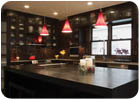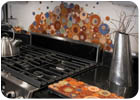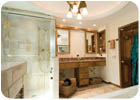
Mosaics
continue to be a popular choice in both residential and commercial designs. For
this kitchen, the homeowner preferred a subdued look. She selected custom
mosaics with texture for the backsplash, which complemented the high-end
appliances. Mosaics Supplier: Mercury
Mosaics, Minneapolis, MN
Mosaics have been adorning classic building interiors for centuries, and when surveying many of today’s applications, it is evident that they still hold their aesthetic value in contemporary design. And with the broad range of materials, colors, sizes and finishes found in the marketplace today, these tiny pieces are highly visible in a range of residential and commercial applications. Whether used as a primary design element or as a decorative accent, mosaics have become a mainstay for a range of project types.
In the residential sector, mosaics are transforming areas such as bathrooms, kitchens and foyers into dynamic spaces. While bold colors and reflective glass surfaces can create playful and whimsical designs, sleek metallics or a matte finish conjure a more sophisticated and subdued atmosphere.
Custom mosaics are also inspiring more unique forms of design. The seemingly endless array of color, shapes and finishes provides architects and designers - as well as homeowners - with the ammunition to create vivid interior designs with a great amount of depth and texture.
With 10 years of experience in producing custom mosaics, Mercedes Austin of Mercury Mosaics in Minneapolis, MN, believes there has been a surge in demand for them in recent years. “I actually discovered [mosaics] in a hand-made tile shop in the neighborhood that I moved into,” she said. “I was attracted to a tile sign. I had no experience in tile. I was finishing up art school at the time. It appealed to me that tile is art, but practical as well.”
The artist’s fascination with mosaic tile led her to open her own studio for producing custom mosaics. “I see them being used frequently,” she said. “People are using custom mosaics and handmade tile a lot more. With the economy tanking, we are still thriving.”
Mercedes believes that because of the downturn in the housing market, people realize that they are going to be in their homes for a while. As a result, when doing upgrades, they are spending money and choosing something that they really like.
“Mosaics used to be ultra custom,” said Mercedes. “Now we are making more general shapes, and customization comes with the colors that we are using.”

For
a recent residential project, Mercedes Austin of Mercury Mosaics created mosaic
tiles that resemble bubbles in a mix of sizes and colorful shades. The pieces
were employed for a kitchen backsplash behind the stove -- creating a unique
colorful piece of artwork.
For a recent residential project, Mercedes created mosaic tiles that resemble bubbles in a mix of sizes and colorful shades. The pieces were employed for a kitchen backsplash behind the stove - making for colorful artwork.
Another client preferred a more subdued look for her kitchen. “We used a more basic shape,” she explained. “[The homeowner] didn’t really want it to be super busy. She wanted an interesting texture, and she wanted the tile to go with the high-end appliances. She wanted the mosaics to add to the whole aesthetic rather than be a feature.” While the majority of her work is in the residential sector, Mercedes also has designed custom mosaics for commercial projects. “Kitchens and baths remain pretty consistent, but I am noticing, however, commercial projects are starting to introduce handmade tile,” she said. “I think, in the past, people were skeptical because of the price point.”
The artist explained that she has recently worked with Whole Foods Market, a retailer of organic and natural food. The company has started to use custom mosaics in their store locations. “The color blend is called ‘bamboo,’ and they are using it above soffits over the sushi bar.”
Overall, Mercedes believes that designers are continually expanding their imaginations to develop unique ways to utilize stone and tile in their designs -- even when a space is small or budgets are limited. “Designers are extremely creative these days,” she said. “They will see how they can put 60 square feet [of material in a space] and make it the center of the design. Good design is just pouring into everything.”

A
remodel of a master bath in a private residence that overlooks Schmidt Lake
in Minnesota
utilized Honey Onyx mosaics and porcelain tile to create a design reminiscent
of a Roman bath. Architect: Vujovich Design Build, Minneapolis, MN;
Mosaics/Tile Supplier: Tile By Design,
Inc., Plymouth, MN; Tile Installer: Trends in Tile & Stone Inc.,
Minneapolis, MN
Accessorizing a Design
Jennifer Books, Associate AIA, with Vujovich Design Build, also in Minneapolis, MN, agrees that mosaics can contribute to the overall character of a living space and reflect a homeowner’s personality. “They become part of the jewelry of the home,” she said.Recently, Vujovich Design Build completed a remodel of a master bath in a private residence that overlooks Schmidt Lake in Minnesota. Honey Onyx mosaics were paired with porcelain tile -- dressing up the overall look of the room. The materials were supplied by Tile By Design, Inc. in Plymouth, MN, and the installation was completed by Trends in Tile & Stone Inc. of Minneapolis.
“The inspiration came from wanting to have a Roman bath,” said Books. “The launching point for that was a retreat destination. Something that reflected timelessness and tranquility.”
The architect explained that there is a lush garden surrounding the lake home, which influenced the style of design for the master bath. “The garden in itself is a retreat,” she said.
“The homeowners wanted the same experience, but with a different vocabulary for the bathroom.”
The Honey Onyx mosaics and porcelain - referred to as Mediterranea Vatican City - were key components in creating the Roman bath style that the homeowners desired. “A specific feature that drove the design was the desire to have the tile floor feel like a custom area rug,” said Books. “[From there] the 1- x 1-inch Honey Onyx mosaics rippled into the remaining areas.”
In addition to the floor pattern, the mosaics form an accent border in the shower stall and clad the top of the tub surround. The porcelain, which resembles the look of Italian marble, was employed as 10- x 20-inch tiles for the field of the floor as well as the shower walls. The porcelain was used in a 20- x 20-inch format for the tub surround.
Keeping the environment in mind, the homeowners chose to reuse the marble vanity top and faucets from the original bathroom. The rich red tones of the stone further enhanced the feel of a Roman bath.